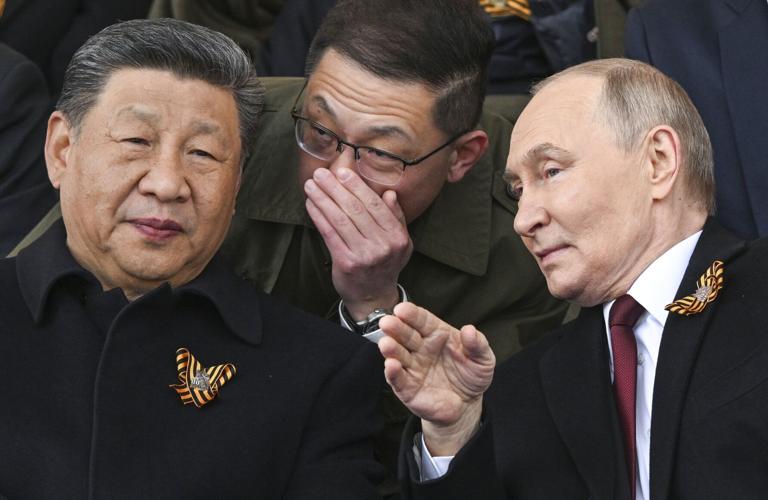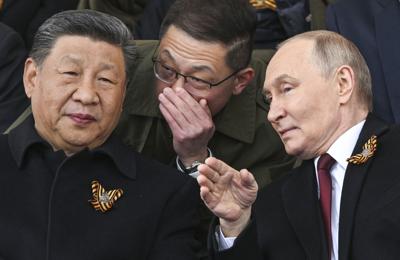While World War II (WWII) progressively diminishes in importance for many in the United States, the Great Patriotic War, in Russian parlance, continues to weigh heavily on many of Washington’s primary competitors and heretofore staunchest allies. One only has to view the visitors' stand at this year’s May 9 Victory Day parade in Moscow to understand the abiding hold the conflict maintains on much of the world.
Starting with the pageant host, Tsar Vladimir (I want to be) the great has consistently tied Moscow’s 1945 victory over Hitler’s Germany to the ongoing “special military operation” in Ukraine. By defining one of the main goals of the Kremlin's assault on its Slavic neighbor as the “denazification” of Ukraine, Putin effectively painted the regime in Kyiv as a successor to the great German threat of the 1940s. Given that the scars of the Nazi attack on Russia — Operation Barbarossa, June 22, 1941 — are hard-wired in the Russian DNA, the current Kremlin chief’s narrative has enjoyed widespread acceptance across the country’s 11 time zones.
Though some Ukrainians did willingly collaborate with the Nazis against the Soviet Union during WWII, they did so primarily due to their visceral hatred of the Russians who, under Joseph Stalin’s forced collectivization in the 1930s, effected a brutal famine (holodomor) which killed several million Ukrainians. The river of mutual enmity between these neighbors flows unimpeded to this day.
Sitting to Putin’s right during this year’s glorification of Russian military prowess was China’s President, Xi Jingping. It is fair to state that modern China was birthed in the geopolitical detritus of WWII, with the establishment of the People's Republic in 1949 following the Communist Party’s victory over Chiang Kai-shek’s Nationalist Party, which in defeat withdrew to Taiwan. Xi sees the eventual reunification of the mutinous island with the mainland as a logical closing chapter to China’s WWII saga.
Furthermore, since coming to power in 2013, President Xi has been on a mission to return the Middle Kingdom to its former greatness, an idealized past before the country’s fortunes reached a bloody nadir at the hands of Japan during WWII. An integral part of Xi’s long term strategy is to challenge the United States — the post-war world’s predominant power — for global supremacy, in the process righting the wrongs of the decades leading up to the second world war.
One other visitor to Putin’s military bash is worth highlighting. The Prime Minister of Slovakia, Robert Fico, proudly wore his black sheep of Europe cloak and joined the party. The significance of Fico’s attendance is that he represented the only leader from a European Union or North Atlantic Treaty Organization (NATO) country to attend. His presence confirms that while Europe is generally united in addressing the greatest security threat to the continent since WWII, political fissures in the edifice of Europe, particularly in the haunted lands between the Danube and the Dnepr, are clearly widening. From Poland on the Baltic to Bulgaria on the Black Sea, the newly-independent countries of this region are caught between their aspirations for freedom and prosperity and the malign geographic pull of Moscow’s orbit.
When analyzing the participants in Putin’s recent May 9 dance party, of equal remark is which countries did not participate. Prominent among the no shows were France and Poland, two countries who played substantive roles in the military conflagration that engulfed the continent from 1939-1945. The two nations did, however, make news recently by signing an extensive strategic agreement, the military aspects of which harken back to French security guarantees to Warsaw in the lead up to… you guessed it, WWII. The current deepening of military ties between the two allies is seen as a response to heightened European disquietude about Washington’s perceived lack of fealty to its NATO Article 5 commitments.
Speaking of the red, white and blue, we also thankfully skipped Putin’s propaganda parade on May 9. It is worth noting, though, that for most Americans June 6, D-Day, is a more representative commemoration of our country’s victory in Europe in WWII. Despite the fact that the battles raged across Europe after D-Day for another 11 months, the assault on the Normandy beaches resonates more poignantly for many on this side of the Atlantic than the actual final victory. Perhaps it is the “Saving Private Ryan” effect on our collective memory.
Nevertheless, despite the eight decades that have passed since WWII ended in Europe, many of the combatant nations have yet to break free from the historical and psychological shackles of the most Homeric struggle of the past century. In light of this, it is incumbent on anyone trying to make sense of today’s geopolitics to look back on the monumental events that culminated four score years ago.








